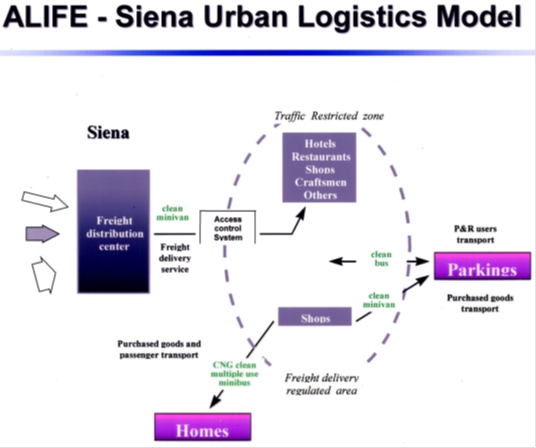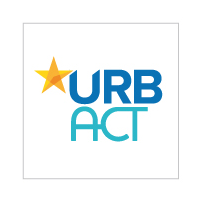Freight TAILS – delivering Tailored Approaches for Innovative Logistics Solutions
Edited on
26 May 2016Interview with from Charlotte Knell (Lead Partner Westminster), Councillor Heather Acton, Dan Dura and Deputy Mayor Lucian Harşovschi from Suceava (project Partner City) interviewed by Matthew Jackson, lead expert of Freight Tails project

This article is the result of a composite interview bringing together information and remarks from Charlotte Knell (Lead Partner Westminster), Councillor Heather Acton, Dan Dura and Deputy Mayor Lucian Harşovschi from Suceava (project Partner City)
The City of Westminster is, for many evident reasons, an iconic location at the very centre of the UK capital. So while London has launched some pioneering approaches to city and mobility management over recent years, Westminster and the adjoining central boroughs which constitute the “Cross River Partnership”[1] have been at the very heart of these developments - specifically in relation to transportation and in close collaboration with the metropolitan agency “Transport for London”[2]. The introduction of congestion charges and evolution through formation of low emission zone to current implementation of an ultra-low emission zone - together with countless initiatives to improve economic conditions, public transport performance, road safety, encouragement for pedestrians and cyclists, quality and functionality of public space - is characteristic of recent London and inevitably Westminster/Cross River Partnership experience. Like Paris the scale of the city has not inhibited the urge to explore alternative and innovative solutions to counter negative impacts and externalities associated with the essential demands of accessibility and efficient movement of goods and services
This drive to explore, experiment and search for good practice and new mobility management mechanisms has led the City of Westminster to participate actively in EU programmes: via the LaMilo project (end user perspectives on Last Mile Logistics) in INTERREG IVB (NWE); through lead position in FREVUE (Freight Electric Vehicles in Urban Europe) as part of the 7th Framework Programme, and; as Lead Partner and Partner respectively in the EVUE (Electric Vehicles in Urban Europe)/EVUE II and URBACT Markets projects in URBACT II. A good moment perhaps to examine Westminster’s motivation to mount a new Action Planning Network in URBACT III, namely the Freight TAILS project.
The City of Westminster is happy to support the new URBACT Action Planning Network: Freight TAILS. We are acutely aware of the impact freight movements have in our city, in terms of traffic congestion making it cost more to do business in the city; the increase in air pollution and the very real negative impact that has on our citizens' health; and not least the impacts of delivery and servicing activity on the safety of our roads. We are looking forward to working with local stakeholders including our Business Improvement Districts and Transport for London, to develop our Integrated Action Plan. Freight TAILS also provides us with a fantastic opportunity to share our experiences across our Network of Freight TAILS cities and beyond, transferring knowledge and raising capacities. Councillor Heather Acton
Delivery and dispatching of goods in our urban concentrations has long been one of the weakest links in urban mobility management practice. Urban freight and logistics is so fundamental to the very existence of cities, and yet despite forward looking initiatives, notably in historic towns like Siena (ALIFE project 1996), comprehensive and effective urban distribution models have consistently proved difficult to pin down. In this context the Freight TAILS coordinator Charlotte Knell underlines the fact that the theme to be addressed by the project is especially relevant today as we continue to experience growth in the urban logistics sector, the added impact of e-commerce coupled with real concern to drastically cut green house gas and particulate emissions as a means of radically improving air quality and public health. Furthermore EU transport policy previews[3] “…halving the use of conventionally-fuelled cars in urban transport by 2030; phasing them out in cities by 2050” and importantly “achieving essentially CO²-free city logistics in major urban areas by 2030”, highlighting that time is not on our side.

For these reasons the idea to develop a project based on the valuable exchange experience of URBACT II was an inviting prospect. The opportunity to work with and share knowledge and approaches with cutting edge cities like Oslo, Stockholm, Madrid, Lisbon and Frankfurt… in EVUE was perceived as a real benefit. Even the interaction with less experienced cities such as Suceava and Katowice allowed Westminster the chance to revisit and evaluate options taken in the past, something for which, in the pressure of ongoing day to day activity, there is often little breathing space – and pass on ideas and techniques to these developing city structures.
So Freight TAILS was appointed to research new (state of the art), effective options in terms of managing urban logistics - based on achieving objectives of sustainability (reducing environmental impact), high performance (efficiency of distribution process) and, economic profitability (reducing operational costs). There has been a strong interest to join the project from cities solicited through the URBACT web partner-dating system, where criteria for acceptance focused on partners with serious interest and experience regarding the topic and demonstration of real will and commitment to participate fully in the exchange and learning method. Maastricht (NL), Parma (IT) and renewing acquaintance with Suceava (RO) would eventually form the team for the project development phase. On the basis of a questionnaire, cities who didn’t make the initial selection, but were placed on a reserve list, have been re-invited to submit their candidacy along with a group selected from a targeted search for partners with either valuable experience or currently involved in developing alternative logistics solutions. The intention is to complete a partnership comprised of 10-11 cities, hopefully including representation from countries such as Croatia, Poland, France, Belgium, Sweden where interest has already been forthcoming.
There is strong local political support in Suceava for participation in a new URBACT initiative. The city is developing plans to improve freight management and operations in the central and commercial areas as part of the first local Sustainable Urban Mobility Plan.
According to Deputy Mayor Lucian Harşovschi In order to achieve the objectives for the next 5 years concerning urban sustainable mobility for our municipality the transfer of best practice and experience from most advanced cities in Europe is essential . This is one of the main reasons that determined us to apply for this new call in the URBACT III programme in the topic of freight mobility.
In the coming months the Lead Partner and Lead Expert are looking to consolidate the theme and sub-themes of the project (identifying transnational cross-cutting issues) based on expression of partner needs and ambitions. Equally partners will be supported and encouraged to build their local (stakeholder) groups as a pre-requisite participatory structure, designed to co-produce concrete local actions targeting urban logistic challenges in their specific context.
[2] Transport for London is a local government organisation (formed in 2000) responsible for managing transport services and implementing transport strategy in the Greater London area.
[3] EU White Paper – Roadmap to a Single European Transport Area: 2011
 Submitted by URBACT on
Submitted by URBACT on
